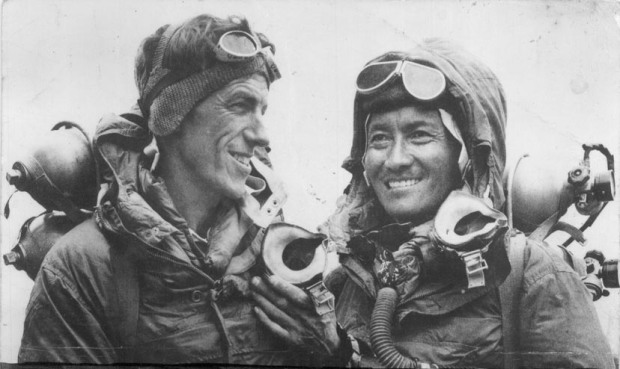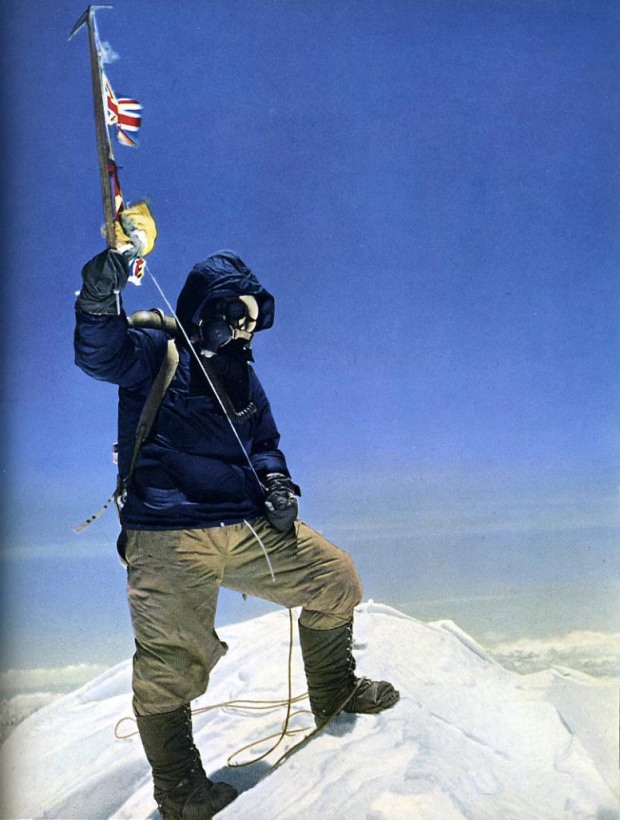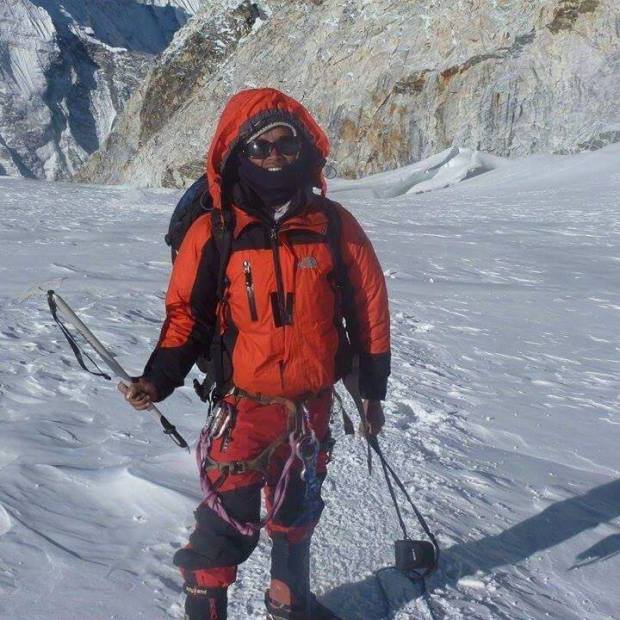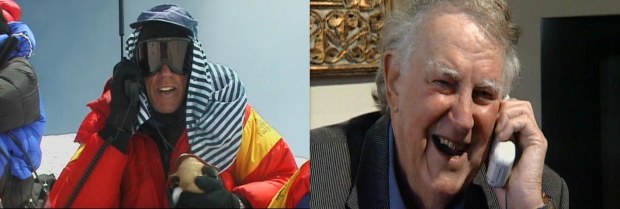Credits picture: National Geographic
It’s the middle of the night, but the Everest base camp is already waking up. It’s a misty morning on the South Side of the mountain that Nepali people call Sagarmatha. Sherpas are checking their equipment before beginning the climb of the Ice Fall of Khumbu. Today, Sherpas have to bring the mountaineers their equipment at Everest Camp One at 6065m. Each time before they leave, they do a Buddhist Puja. The feeling of anxiety is in the air as the Sherpas finally being their climb. Some hesitate at the sheer drop below them. It’s silent; all that can be heard is the snow crackle under their feet. Suddenly, a massive noise breaks the peace of the mountain. The Sherpas look above their heads to see snow flowing towards them. One of them screams « AVALANCHE !!!! ». The unbearable silence suddenly returns. At Base Camp, everyone is woken up by the noise, quietly shocked. A voice on the radio transmitter is screaming « Base Camp, Base Camp, We need help, so many people dead here… ». (Discovery Channel, Sherpas: Trouble on Everest)
On 18 April 2014, 16 people died in an avalanche between Base Camp and Camp One. All the victims were Sherpa guides, who were working to realize others’ dreams. It was the worst tragedy that ever happened on Everest. After this, the guides decided not to climb Everest for the rest of the year in memory of their friends.
BEING CLOSE TO DEATH MAKE THEM FEELING ALIVE
THE CONQUEST: “THEY DID NOT KNOW IT WAS IMPOSSIBLE, SO THEY DID IT“ – MARK TWAIN

Edmund Hillary and Tenzing Norgay region of Everest (1953) Credits: Peter Hillary

Tenzing Norgay on the top of Mount Everest (1953) Credits: Peter Hillary
The 29th of May 1953, two men walk for the first time of the humanity on the top of the world, the Mount Everest. Edmund Hillary and his Sherpa Tenzing Norgay were not the first to brave the limits of the possible, but on this day they were the first to succeed. Heidi Sand, a German mountaineer that summited Mount Everest in 2012 as a remission cancer gift said about the top of the world “I still feel ice-coldly the back down when I think of this magic moment.“ Probably Hillary and Tenzing had a similar feeling. Edmund Hillary said later that he would never come back alive without the help of Tensing that bear him on the descent. This event completely changed sherpas lives thanks to the media coverage of Tenzing Norgay. He became a national hero, almost consider as a god for some. Tenzing is part of the ethnic group of Sherpas. Indeed, Sherpas became the guide of Himalaya. This event also made of them the wealthiest Nepali cast. Nowadays hundreds of expeditions go on the high Himalaya summits as Everest. These expeditions need people to bring their equipment to the different altitude camps. Sherpas guide makes this work. They carry about 20kg of equipment per trips at altitudes where life is almost impossible. Sherpas guide don’t make it once or twice as the mountaineers; they do it about 30 times in the season. More trips they do better pay they are. On the final ascent to the summit, they became the guarantors of mountaineers’ lives by holding their oxygen and often saving their lives. Sherpas have a huge respect to mountains, Ngima Sherpa, a young 25 Sherpa guide said: “Mountains are our god gift.“
THE LIMITS OF LIVING: “IF YOU CAN DREAM IT, YOU CAN DO IT“ – WALT DISNEY
Nowadays, people used to think that summit the Everest became accessible to almost everyone. Yes, the ascent is considerably easier than in 1953. However, the risk of dying is still high. Nowadays, Sherpas called Ice Fall Doctors take almost all the physical risk by creating a way to the summit. At the beginning of the season, they have to put ladders above crevasse and move it every day to adapt to Ice Fall modifications. Indeed, the Ice Fall because of the climate change is moving of about 1m per day.
The main risk for mountaineers today is altitude. In mountaineering, we call the zone above 7500 m, the death zone and it bears well its name. In altitude, 1/2 of people suffers from hypoxia (oxygen deficiency) which affect the cerebral ability and the proper functioning of organs. This issue can lead people to commit suicide or to take inconsiderable risks, it also leads 1/5 of people to pulmonary or cerebral edema. Most of the people died on the Everest suffered from this mountain sickness. Scientists agree on the fact that life is impossible on a long term above 7500m. People that died above this altitude stay forever there, it’s too dangerous to take down their body. It’s like a warning that mountains are making its law. Sherpa people are living in Himalaya mountains for centuries and developed a blood modifications that permits to them to better support altitude. Sherpas people have an optimized blood with a higher number of red blood cells to transport faster oxygen. Usual people can benefits of this modifications too but with a long exposition to altitude.
With so much risk why doing that? Why smelling every time in that conditions? The minds about it are quite different between mountaineers and Sherpa. Peter Hillary, New Zealander mountaineer who summited the top seven summits of the world and son of Edmund Hillary thinks “We could die every day in a car crash so why not doing incredibly dangerous things as Mount Everest.“ Heidi Sand, just quoted her favorite writer “You must try the impossible to reach the possible“We can hear a kind of fatality in Sherpa mind but also a passion. “I do this all for my children. My daughter wants to be air hostage abroad, and my son wants to be a great Lama.“ Lhakpa Sherpa, SWS Sherpa Guide explained about his motivations. Tashi Lakpa Sherpa see his job more as a contribution to his country wellbeing and said: “Our smile is for our nation!“
RISKING THEIR LIVES FOR OTHERS DREAM
THE COST OF THE MOUNTAIN

Lhakpa Sherpa, SWS Sherpa Mountain guide

Ngima Sherpa, Sherpa Mountain Guide
Mountains have two cost. Indeed, first since 1990, Everest became a business for tourism agency and people are ready to pay thousands of pounds to summit Everest. But mountains also have such higher cost, the cost of life. Since 1953, about 250 people died on the wild Everest and 1/3 of them were Sherpa guides. Who is paying the greater price? Nowadays, a mountaineer will pay a trekking agency about 50 000$ to do Everest summit and a Sherpa is paid about 5000$ for two months of work. Sherpas are well paid compare to the rest of the Nepal. However, compare to the risk take it’s quite low. Tashi Lakpa Sherpa is a famous Sherpa guide that summited eight times Everest and several times summits above 6000m. He said about their salary “How we can say enough?“.
The commercialization of trekking had an appalling impact on the risk that sherpas take. Indeed, the competition between agency lead sometimes to don’t follow the security instructions. It’s exactly what happened in 1996. Two expeditions were on the final ascent on the 10th May 1996. For the final ascent, there is a limit hour at the summit to respect (1 pm), if an expedition arrives too late, they will go down by night and weather is often bad during night. First, issues, the two Sherpas that should prepare the ropes are sick and stayed behind the group. The leader of expeditions are wasting hours and hours to fixed it. The 33 mountaineers have to wait much longer than they should. Indeed some have almost no experience of mountaineering and take time on the ropes. “We can compare it with jumping in the water without know how to swim“ the Sherpa guide Lhakpa Sherpa explained about mountaineers without experience. It’s 4 pm the last mountaineer arrived at the top. The night is coming with a strong storm. This night eight people died because the two leaders of the expeditions were in competition and wanted to do the summit to have more clients next year. This accident also lead Sherpas in the next days to take risks to try to find survivors.
Movie trailer Everest (2015) film about the 1996 Everest disaster according to the book Into thin air written by Jon Krakauer
“The risk that people are making the sherpas take. What is the moral justification for that?“ said a mountaineer for Discovery Channel (Sherpas Trouble on Everest, 2015) Unfortunately there a lot of stories like that. Bipin Lamichhane Sherpa Guide for Himalaya Gateway Trek, tell his worst memories of his career: “I remember, three years ago, I was doing a trek with ten people to the Annapurna, the most dangerous summit of Nepal. When we begin to climb, the mountain became like hell. Snow never stop falling and there were avalanches everywhere. I knew it was dangerous but clients wanted to go whatever the risk. We respect mother mountain and I always though it was not a good idea to continue and tried hard to bring them back to Katmandu. Unfortunately, I was not convincing enough, and some never came back.“. Peter Hillary remember of the terrible earthquake that hit Nepal in 2015 “I was at Everest Base Camp, so many people died in the avalanche caused by the earthquake and especially a lot of Sherpas. It was terrible.“
Sherpa guides are conscious of the risk they take and Ngima Sherpa just said: “I have to be brave.“ He said it like a fatality and he looks not to be the only one to think that, Bipin Lamichhane said with this same fatality in the voice “It’s my duty“. Mountaineers are divided on their responsibility about Sherpas’ lives “I don’t feel I risked the life of the Sherpas. Not at all.“ said Heidi Sand. Peter Hillary thinks he has a great responsibility it’s why he prefers that Sherpas stay in base camp when it’s possible “Sherpa get paid more and feel proud but they take greater risk and it’s a greater responsibility for us too. I don’t want that someone died to achieved MY dream.“
Documentary about the causes of the 1996 disaster on Mount Everest (National Geographic, 2016)
THE UNSUNG HEROES

Peter and Edmund Hillary by phone on the top of Everest (2002)

Peter Hillary and Jamling Norgay, sons of Edmund Hillary and Tenzing Norgay
“I’m happy if someone is trying their best to achieve its dream. But sometimes because people wants celebrity they don’t show our hard work to help them achieved it, that’s why we are the unsung heroes!“ Tashi Lakpa Sherpa explained about the lack of gratitude towards Sherpas. He explained that without Sherpas help most of the people that trying Everest will not succeed or will die. It’s how Sherpas’ life is going, working behind the clients, always smiling and let them believe that they are heroes. Ngima Sherpa highlights a quite strong feeling we can have when we are talking to Sherpas: “I think Sherpa people are naturally shy.“ He explained it’s probably why we don’t hear that much about Sherpas in the International news. The mountaineer Peter Hillary have the same mind on it even if progress were made: “Media give more and more the speaking to those who deserve it. But it’s true that media don’t mention that much Sherpas.“
Peter Hillary also highlights the fact that Sherpas are not really interested in celebrity or usual gift. “Himalayan Trust was created by friendship. My father wanted to know if there something that he could do for sherpas and he honestly though they will ask for more money or holidays in America, the usual answers. One of his Sherpa friends said, “Would you build us a school for our children ? ». My father accepted and created Himalayan Trust. Sherpa could be able to get an education and develop their lives. We build 42 schools and hospitals, and we also lead education program in Sherpas land. They are now able to move in other areas of jobs than mountaineering or farming.“ He added “My father could never do what he did without Tenzing, and would not come back alive. Tenzing bore him to go down. I was born in 1954, I would not even exist without Sherpas. We have to be grateful, they give us the opportunity to summit the impossible.“
Aurélie Denieul









